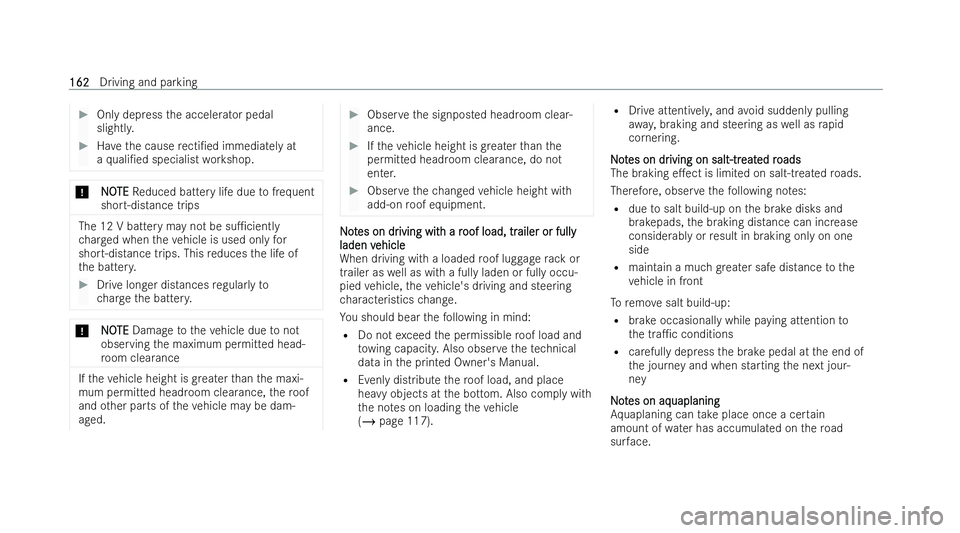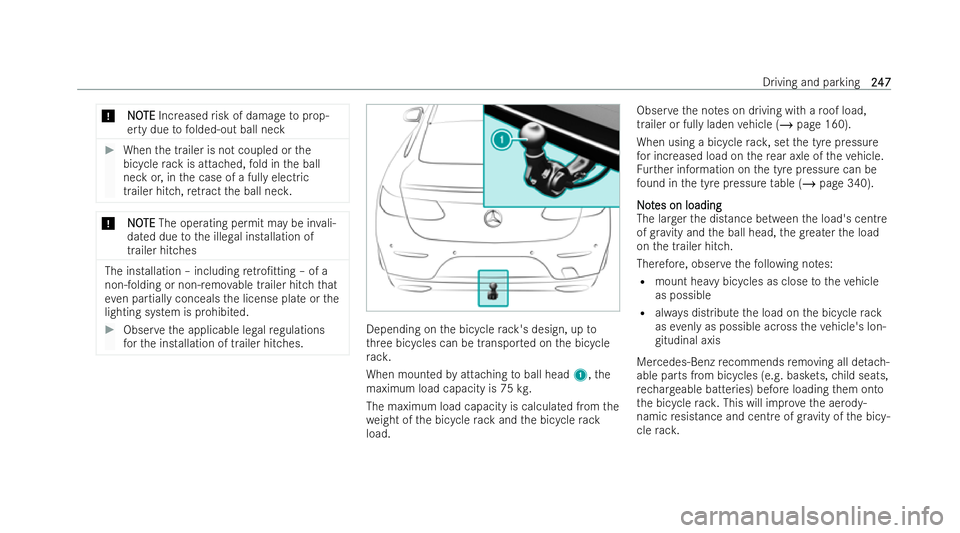Page 23 of 481

Pr
ot
Pr otection of t
ection of t he en
he envir
vironment
onment
+ ENVIR
ENVIR
ONMENT
ONMENT AL NO
AL NOTE
TE Environmental
damage due tooperating conditions and
personal driving st yleThe pollutant emission of
theve hicle is
directly related tothewa yyo u operate the
ve hicle.
Operate your vehicle in an environmentally
re sponsible manner tohelp pr otect the envi-
ro nment. Please obser vethefo llowing recom-
mendations on operating conditions and per-
sonal driving st yle.
Oper
Oper ating conditions:
ating conditions: #
Make sure that the tyre pressure is cor-
re ct. #
Do not car ryany unnecessary weight
(e.g. roof luggage rack s once you no lon-
ge r need them). #
Adhere tothe service inter vals.
A regula rly serviced vehicle will cont rib-
ute toenvironmental pr otection. #
Always ha vemaintenance workcar ried
out at a quali�/ed specialist workshop.
P
P er
er sonal dr
sonal dr iving s
iving stytyle:
le: #
Do not depress the accelerator pedal
when starting the engine. #
Do not warm uptheve hicle while sta-
tionar y. #
Drive carefully and maintain a suitable
distance from theve hicle in front. #
Avoid frequent, sudden acceleration and
braking. #
Change gear in good time and use each
ge ar only up toÔ of its maximum
engine speed. #
Switch o�. theve hicle in stationary traf-
fi c, e.g. byusing the ECO start/s top
function. #
Drive in a fuel-e�1cient manner. Obse rve
th e ECO display for an economical driv-
ing style. T T
ak
ak e-bac
e-bac k of end-of-lif
k of end-of-lif e v
e vehicles
ehicles
EU countr
EU countr ies only:
ies onl y:
Mercedes-Benz will take back your end-of-life
ve hicle for environment-fri endly disposal in
accordance with the European Union (EU) End-of-
Life Vehicles Directi ve.
A network of vehicle take -back points and dis-
mantlers has been established foryo uto return
yo ur vehicle. You can lea veit at any of these
points free of charge . This makes an impor tant
cont ribution toclosing there cycling circle and
conserving resources.
Fo r fur ther information about there cycling and
disposal of end-of-life vehicles, and theta ke -back
conditions, please visit the national
Mercedes-Benz website foryo ur countr y. 20
20
General no
tes
Page 165 of 481

#
Only depress the accelerator pedal
slightl y. #
Have the cause recti�/ed immediately at
a qu ali�/ed specialist workshop. *
N
NOOTE
TE Reduced battery life due tofrequent
short-distance trips The 12 V battery may not be su�1cien
tly
ch arge d when theve hicle is used only for
short-dis tance trips. This reduces the life of
th e batter y. #
Drive longer distances regula rly to
ch arge the batter y. *
N
NO
OTE
TE Damage totheve hicle due tonot
observing the maximum permitted head-
ro om clearance If
th eve hicle height is greater than the maxi-
mum permitted headroom clearance, thero of
and other parts of theve hicle may be dam-
aged. #
Obser vethe signposted headroom clear-
ance. #
Ifth eve hicle height is greater than the
permitted headroom clearance, do not
enter. #
Obser vethech anged vehicle height with
add-on roof equipment. N No
ot
tes on dr
es on dr iving wit
iving with a r
h a roof load, tr
oof load, tr ailer or fully
ailer or fully
laden v
laden v ehicle
ehicle
When driving with a loaded roof luggage rack or
trailer as well as with a fully laden or fully occu-
pied vehicle, theve hicle's driving and steering
ch aracteristics change.
Yo u should bear thefo llowing in mind:
R Do not exceed the permissible roof load and
to wing capacity. Also obser vethete ch nical
data in the printed Owner's Manual.
R Evenly distribute thero of load, and place
heavy objects at the bottom. Also comply with
th e no tes on loading theve hicle
(/ page 117). R
Drive attentivel y,and avoid suddenly pulling
awa y,braking and steering as well as rapid
cornering.
N
No ot
tes on dr
es on dr iving on salt-tr
iving on salt-tr eat
eated r
ed r oads
oads
The braking e�.ect is limited on salt-treated roads.
Therefore, obser vethefo llowing no tes:
R due tosalt build-up on the brake disks and
brakepads, the braking distance can increase
considerably or result in braking only on one
side
R maintain a much greater safe distance tothe
ve hicle in front
To remo vesalt build-up:
R brake occasionally while paying attention to
th e tra�1c conditions
R carefully depress the brake pedal at the end of
th e journey and when starting the next jour-
ney
Not
Not es on aq
es on aq uaplaning
uaplaning
Aq uaplaning can take place once a cer tain
amount of water has accumulate d onthero ad
sur face. 162
162
Driving and parking
Page 250 of 481

*
N
N O
OTE
TE Increased risk of damage toprop-
erty due tofolded-out ball neck #
When the trailer is not coupled or the
bicycle rack is attached, fold in the ball
neck or, in the case of a fully electric
trailer hitch, retract the ball nec k. *
N
N O
OTE
TE The ope rating permit may be in vali-
dated due tothe illegal installation of
trailer hitches The installation – including
retro�/tting – of a
non- folding or non-remo vable trailer hitch that
eve n partial lyconceals the license plate or the
lighting system is prohibited. #
Obser vethe applicable legal regulations
fo rth e installation of trailer hitches. Depending on
the bicycle rack 's design, up to
th re e bicycles can be transpor ted on the bicycle
ra ck.
When mounted byattaching toball head 1,the
maximum load capacity is 75 kg.
The maximum load capacity is calculated from the
we ight of the bicycle rack and the bicycle rack
load. Obser
vethe no tes on driving with a roof load,
trailer or fully laden vehicle (/ page 160).
When using a bicycle rack , set the tyre pressure
fo r increased load on there ar axle of theve hicle.
Fu rther information on the tyre pressure can be
fo und in the tyre pressure table (/ page 340).
N
No ot
tes on loading
es on loading
The lar gerth e distance between the load's centre
of grav ity and the ball head, thegr eater the load
on the trailer hitch.
Therefore, obser vethefo llowing no tes:
R mount heavy bicycles as close totheve hicle
as possible
R always distribute the load on the bicycle rack
as evenly as possible across theve hicle's lon-
gitudinal axis
Mercedes-Benz recommends removing all de tach-
able parts from bicycles (e.g. bask ets, ch ild seats,
re ch arge able batteries) before loading them onto
th e bicycle rack . This will impr ovethe aerody-
namic resis tance and centre of grav ity of the bicy-
cle rack. Driving and parking
247
247